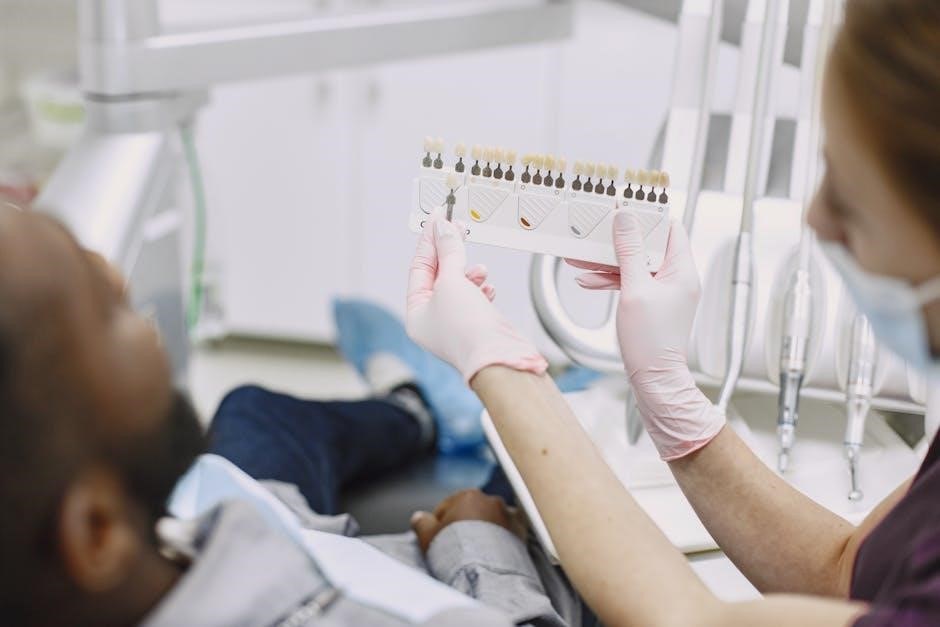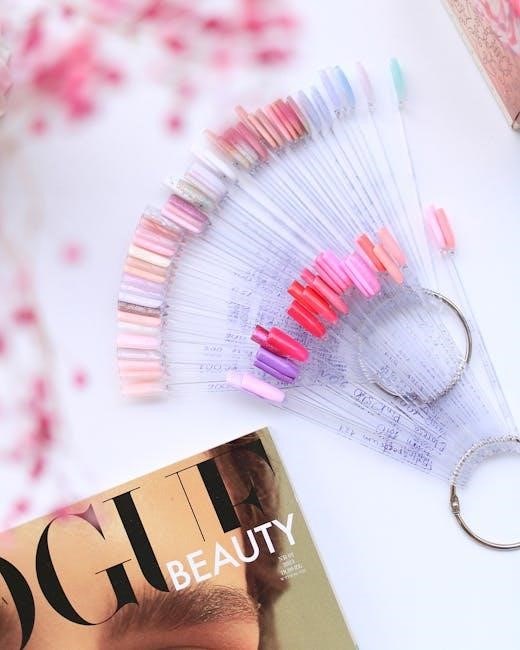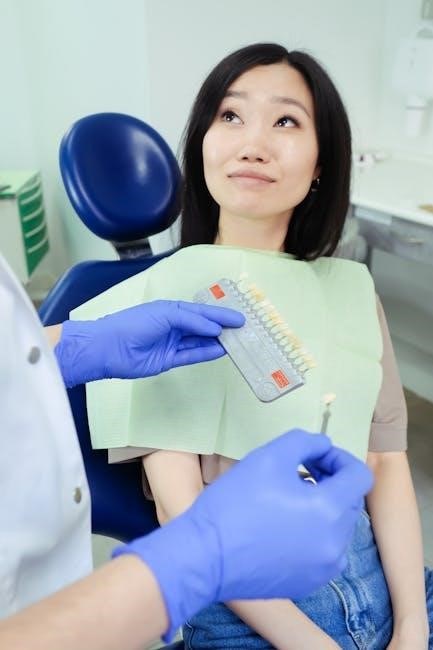Tooth shade guides are essential tools in dentistry for matching tooth color accurately during various procedures. They enable dentists to select the most natural and aesthetically pleasing shades‚ ensuring optimal results for patients; By providing a standardized reference‚ these guides enhance the precision and effectiveness of dental treatments‚ making them indispensable in modern dental practices.
1.1 Definition and Purpose
A tooth shade guide is a standardized tool used in dentistry to accurately match the color of natural teeth or dental restorations. It consists of a series of tabs or samples representing different shades‚ organized into groups like A (reddish brown)‚ B (reddish yellow)‚ C (gray)‚ and D (reddish gray). The purpose of these guides is to ensure that dental treatments‚ such as veneers‚ crowns‚ and implants‚ blend seamlessly with the patient’s natural tooth color; By providing a visual reference‚ tooth shade guides enhance precision and communication between dentists‚ technicians‚ and patients‚ helping to achieve aesthetically pleasing and functional outcomes.
1.2 Brief History of Tooth Shade Guides
The concept of tooth shade guides dates back to the early 20th century‚ with the Vita Classical Shade Guide emerging as a landmark innovation. Initially developed to standardize tooth color matching‚ these guides evolved from basic systems to more sophisticated tools. The Vita system introduced organized shade groups—A‚ B‚ C‚ and D—each with subcategories‚ revolutionizing dental aesthetics. Over time‚ digital advancements have complemented traditional guides‚ enhancing accuracy and efficiency. This evolution reflects the growing importance of aesthetics in dentistry‚ ensuring that tooth shade selection remains precise and patient-centric‚ with ongoing innovations continuing to shape the field of dental color matching.
1.3 Importance in Modern Dentistry
Tooth shade guides play a pivotal role in modern dentistry‚ ensuring natural and aesthetically pleasing outcomes for patients. They are indispensable in restorative and cosmetic procedures‚ such as veneers‚ crowns‚ and implants‚ where precise color matching is critical. These tools enhance communication between dentists and technicians‚ fostering consistency and accuracy. By standardizing shade selection‚ they minimize errors and improve patient satisfaction. Additionally‚ they aid in documenting tooth color for future reference‚ making them essential for maintaining high standards in dental care and ensuring that treatments align with patients’ expectations for both function and appearance.

The Vita Classical Shade Guide
The Vita Classical Shade Guide is a widely recognized system for tooth color matching‚ categorizing shades into four main groups (A‚ B‚ C‚ D) with 16 distinct variations.
2.1 Overview of the Vita System
The Vita system is a standardized tool for tooth color matching‚ widely used in dentistry. It categorizes tooth shades into four main groups: A (reddish-brown)‚ B (reddish-yellow)‚ C (gray)‚ and D (reddish-gray)‚ with each group containing four subcategories for precise shade selection; This system aids dentists in achieving natural-looking results for restorations and cosmetic procedures. Its simplicity and accuracy make it a preferred choice among dental professionals‚ ensuring consistent and reliable outcomes in various clinical applications.
2.2 The Four Main Shade Groups (A‚ B‚ C‚ D)
The Vita system categorizes tooth shades into four primary groups: A‚ B‚ C‚ and D. Group A represents reddish-brown hues‚ Group B includes reddish-yellow shades‚ Group C features gray tones‚ and Group D encompasses reddish-gray colors. Each group is further divided into subcategories‚ providing a detailed spectrum for precise matching. These groups serve as a foundational reference for dentists to identify and replicate natural tooth colors accurately‚ ensuring aesthetic consistency in dental restorations and cosmetic procedures. This classification system is widely recognized for its simplicity and effectiveness in achieving natural-looking results.
2.3 Subcategories Within Each Group
Beyond the four main groups‚ the Vita system further divides each category into subcategories‚ numbered 1 to 4. These subcategories refine the color selection process‚ offering variations in brightness‚ chroma‚ and hue. For instance‚ within Group A‚ shades range from lighter (A1) to darker (A4) tones‚ allowing for precise customization. This detailed segmentation ensures that dentists can closely match the natural color of a patient’s teeth‚ enhancing the aesthetic outcomes of restorations like veneers‚ crowns‚ and implants. This level of granularity makes the Vita guide a versatile tool for achieving highly individualized results in dental procedures.

Digital Tooth Shade Matching
Digital tooth shade matching systems use advanced technology to accurately capture and analyze tooth colors‚ enhancing precision and efficiency in dental procedures. These tools offer real-time results‚ streamlining the shade selection process for dentists and patients alike.
3.1 Advanced Technology in Shade Selection
Digital tooth shade matching utilizes cutting-edge technologies like intraoral cameras and spectrophotometers to capture precise tooth color data. These tools provide real-time analysis‚ ensuring accurate and objective shade selection. Advanced software algorithms enhance color matching by minimizing human error‚ offering consistent results. Digital systems also allow for easy storage and comparison of patient data over time‚ facilitating monitoring of tooth color changes. This technology integrates seamlessly with CAD/CAM systems for prosthetics‚ ensuring restorations match natural teeth perfectly. The use of digital shade matching not only improves efficiency but also enhances patient satisfaction by delivering more predictable and aesthetically pleasing outcomes in dental treatments.

3.2 Benefits of Digital Systems
Digital tooth shade matching systems offer enhanced accuracy‚ consistency‚ and efficiency compared to traditional methods. They minimize human error by providing objective‚ precise color measurements. These systems enable real-time data analysis‚ allowing for quicker and more reliable shade selection. Digital tools also facilitate easy storage and retrieval of patient records for future reference. Additionally‚ they integrate seamlessly with CAD/CAM technologies‚ ensuring precise restoration fabrication. Patients benefit from improved communication‚ as digital visuals help them understand treatment options. Overall‚ digital systems streamline the dental workflow‚ enhance patient satisfaction‚ and deliver superior aesthetic outcomes in dentistry.
3.3 Popular Digital Shade Matching Tools
Popular digital shade matching tools include the Vita EasyShade‚ which uses an intraoral sensor for precise color measurement‚ and the 3M Oral Care Digital Shade Guide‚ offering advanced shade analysis. These tools provide accurate‚ reproducible results‚ enhancing communication between dentists and technicians. They also integrate with CAD/CAM systems for seamless restoration fabrication. Digital tools like the 16-color whitening shade guide track progress effectively‚ ensuring consistent outcomes. These technologies streamline the shading process‚ reduce errors‚ and improve patient satisfaction‚ making them indispensable in modern dental practices.

Factors Influencing Tooth Shade
Tooth shade is influenced by natural color variation‚ aging‚ and dental restorations. These factors impact the aesthetic and functional outcomes of treatments‚ requiring precise shade matching.
4.1 Natural Tooth Color Variation
Natural tooth color varies significantly among individuals due to genetic‚ environmental‚ and anatomical factors. Enamel thickness‚ dentin color‚ and translucency play key roles in determining shade. Teeth naturally range from yellowish to reddish hues‚ with variations often more pronounced between individuals. This diversity necessitates detailed shade guides to ensure accurate matching during dental procedures‚ enhancing both functional and aesthetic outcomes. Understanding these variations is crucial for dentists to achieve natural-looking results in restorations and cosmetic treatments‚ ensuring patient satisfaction and maintaining oral health. Natural variations must be carefully considered in shade selection processes.
4.2 Aging and Its Effects on Tooth Color
Aging naturally alters tooth color‚ leading to a gradual shift toward yellow‚ brown‚ or gray shades. This change occurs as enamel wears away‚ exposing the darker dentin beneath‚ while years of food‚ drink‚ and tobacco stains accumulate. Additionally‚ the dentin itself darkens over time‚ further contributing to tooth discoloration. These age-related changes complicate shade matching‚ as dentists must account for both intrinsic and extrinsic factors. Accurate shade guides are essential to address these challenges‚ ensuring restorations align with the patient’s natural aesthetic. Aging’s impact on tooth color underscores the importance of precise shade selection for maintaining a youthful‚ vibrant smile.
4.3 Impact of Dental Restorations
Dental restorations significantly influence tooth shade‚ as materials like porcelain‚ composite‚ and metal alter the natural color of teeth. These materials can stain differently over time‚ affecting the overall tooth shade. Restorations such as crowns‚ veneers‚ and fillings must be carefully matched to adjacent teeth to maintain aesthetic harmony. Shade guides help dentists select the most suitable shades for restorations‚ ensuring a seamless integration with the patient’s natural smile. The longevity and color stability of restorative materials also play a role in maintaining consistent tooth color‚ making accurate shade selection crucial for both functional and cosmetic success.

The Tooth Whitening Shade Guide
The tooth whitening shade guide helps track progress and monitor results during bleaching treatments. It provides a standardized reference for achieving desired shades‚ ensuring consistent and natural-looking outcomes for patients.
5.1 Understanding Bleaching Shades
Understanding bleaching shades is crucial for achieving desired whitening results. The guide categorizes shades from lightest to darkest‚ helping dentists and patients track progress effectively. It ensures treatments align with aesthetic goals‚ providing a clear visual reference for monitoring changes and maintaining realistic expectations. This systematic approach enhances communication and satisfaction‚ making the whitening process more predictable and successful.
5.2 Monitoring Whitening Progress
Monitoring whitening progress is essential for achieving optimal results. Dentists use tooth shade guides to track changes in tooth color throughout the bleaching process. This allows for precise adjustments and ensures treatments remain on course. Regular comparisons help maintain consistency and accuracy‚ while also managing patient expectations. The guide’s structured format enables clear documentation of improvements‚ making it easier to communicate progress to patients. Specialized tools‚ such as built-in mirrors‚ enhance visibility and accuracy during monitoring sessions; This systematic approach ensures personalized and effective whitening outcomes‚ maximizing patient satisfaction and the success of the procedure.
5.3 Common Whitening Shade Ranges
Common whitening shade ranges are standardized to help achieve consistent and predictable results. Most guides feature a progression of shades‚ often starting from the lightest to the darkest‚ allowing clinicians to track progress. The Vita Shade Guide‚ for instance‚ includes specific bleach shades beyond the natural tooth ranges. These ranges are designed to align with typical whitening outcomes‚ ensuring a natural and aesthetically pleasing result. By referencing these established shade ranges‚ dentists can effectively communicate treatment goals and ensure patient satisfaction. The use of standardized systems ensures reproducibility and accuracy in tooth whitening procedures.

Custom Shade Options
Custom shade options provide tailored solutions for patients with unique dental needs‚ ensuring personalized aesthetics and functionality. They address special cases where standard guides may not suffice.
6.1 Tailored Solutions for Individual Patients
Custom shade options offer personalized solutions to meet the unique dental needs of each patient. These tailored approaches ensure that tooth color‚ shape‚ and aesthetics align perfectly with individual preferences. Advanced tools like custom shade guides and digital matching systems allow dentists to create precise‚ natural-looking results. For patients with distinctive tooth characteristics or specific aesthetic goals‚ custom solutions provide flexibility and accuracy. This personalized care enhances patient satisfaction and ensures that dental restorations blend seamlessly with their natural teeth‚ delivering both functional and cosmetic benefits.
6.2 Special Cases and Exceptions
Certain patients may require special attention due to unique dental conditions or aesthetic preferences. For instance‚ individuals with unusual tooth discoloration or rare dental anomalies need customized shade matching. Additionally‚ cases involving extensive restorative work or highly individualized aesthetic goals may demand deviations from standard shade guides. Advanced tools like custom shade guides and digital matching systems are often employed to address these exceptions. Collaboration between dentists and technicians is crucial to achieve results that meet both functional and cosmetic requirements. These special cases underscore the importance of flexibility and precision in tooth shade selection to ensure optimal patient outcomes.
6.3 Collaboration Between Dentist and Technician
Effective collaboration between dentists and technicians is vital for achieving precise tooth shade matches. Dentists typically communicate specific shade requirements using standardized guides‚ ensuring technicians understand the desired aesthetic and functional outcomes. Advanced tools‚ like digital shade matching systems‚ facilitate this process by providing detailed chromatic data. Technicians then craft restorations that align with these specifications‚ ensuring natural-looking results. This teamwork is particularly crucial in complex cases‚ where custom shades or unique aesthetic preferences are involved. By working together‚ dentists and technicians deliver restorations that seamlessly blend with patients’ natural teeth‚ enhancing both appearance and functionality. Regular communication and mutual expertise are key to success.

Shade Selection for Dental Restorations
Tooth shade guides are vital for selecting shades that match natural teeth in restorations like veneers‚ crowns‚ and implants‚ ensuring a harmonious and aesthetically pleasing outcome for patients.
7.1 Veneers and Crowns
Tooth shade guides play a pivotal role in achieving precise color matching for veneers and crowns. The Vita Shade Guide‚ with its four main groups and subcategories‚ helps dentists select shades that blend seamlessly with natural teeth. For veneers‚ selecting the right shade ensures a harmonious smile‚ while crowns require matching adjacent teeth for a cohesive appearance. Digital tools further enhance accuracy‚ allowing for customized solutions. Proper shade selection is crucial for both aesthetic and functional outcomes‚ ensuring patient satisfaction and restoring confidence in their smile.
7.2 Implants and Dentures
Tooth shade guides are vital for achieving natural aesthetics in implants and dentures. They help match the color of artificial teeth to surrounding natural teeth‚ ensuring a seamless integration. The Vita Shade Guide is commonly used to select shades for implants‚ while systems like Portrait IPN cater specifically to dentures; Digital tools enhance precision‚ allowing for customized shade matching. Proper shade selection ensures both aesthetic appeal and functional compatibility‚ making implants and dentures indistinguishable from natural teeth. This attention to detail enhances patient satisfaction and restores confidence in their smile and overall oral appearance.
7.3 Composite Fillings and Bonding
Tooth shade guides play a crucial role in achieving natural aesthetics for composite fillings and bonding. These tools help select shades that blend seamlessly with the patient’s natural tooth color‚ ensuring invisibility of restorations. The Vita Classical Shade Guide is often used to match composite materials precisely. Digital systems enhance accuracy‚ offering real-time shade analysis. Proper shade matching is essential to avoid visible discrepancies‚ ensuring both functional and aesthetic success. This attention to detail ensures composite fillings and bonding restore teeth naturally‚ maintaining patient confidence and satisfaction with their smile’s appearance and integrity.

Patient Communication and Education
Patient communication and education are vital for successful shade matching. Involving patients in shade selection ensures their expectations are met‚ enhancing satisfaction and trust in dental outcomes.
8.1 Involving Patients in Shade Selection
Involving patients in shade selection enhances their satisfaction and trust. Dentists use tools like shade guides and mirrors to help patients visualize and choose their preferred tooth color. This collaborative approach ensures the final result aligns with the patient’s aesthetic expectations‚ fostering a sense of control and confidence. Open communication about options‚ limitations‚ and recommendations is key. By educating patients on the shade matching process‚ dentists empower them to make informed decisions‚ leading to more personalized and successful outcomes. This partnership is essential for achieving both functional and cosmetic dental goals.
8.2 Managing Patient Expectations
Managing patient expectations is crucial for successful dental outcomes. Dentists use shade guides to discuss realistic results‚ ensuring patients understand achievable goals. Clear communication about treatment possibilities and limitations helps align expectations with reality. Sharing examples or before-and-after cases can provide visual references‚ enhancing patient understanding. By setting realistic goals‚ dentists foster trust and satisfaction‚ ensuring patients are pleased with their final results. This approach minimizes disappointment and maximizes the likelihood of a successful treatment outcome‚ reinforcing the importance of transparency in the dental process.
8.3 Tools for Effective Communication
Effective communication tools‚ such as digital shade matching apps and mirrors‚ enhance patient understanding of tooth shade options. These tools allow dentists to visually demonstrate shade variations and outcomes. Physical models and charts provide tangible references‚ helping patients grasp color nuances. Additionally‚ before-and-after images and simulations can clarify expectations. By using these tools‚ dentists ensure patients are actively involved in decisions‚ fostering a collaborative and transparent process. Such resources bridge the gap between technical details and patient comprehension‚ ensuring alignment and satisfaction with the final dental results.

Shade Guide Maintenance and Care
Proper storage in a cool‚ dry place prevents damage. Regular cleaning and sanitizing ensure accuracy. Updates and replacements maintain relevance with modern dental standards and patient needs.
9.1 Proper Storage and Handling
Proper storage and handling of tooth shade guides are crucial to maintain their accuracy and longevity. They should be kept in a cool‚ dry place away from direct sunlight and chemicals. Storing the guide in its protective case when not in use prevents damage. Handling with clean‚ dry gloves ensures no oils from the skin interfere with the ceramic surfaces. Avoid bending or flexing the guide‚ as this can misalign the shades. Regular inspection for wear or damage is essential to ensure reliability in clinical settings. Proper care extends the life of the guide and maintains its effectiveness in shade matching.
9.2 Cleaning and Sanitizing
Cleaning and sanitizing tooth shade guides are vital to maintain hygiene and prevent contamination. Use mild soap and warm water with a soft cloth to gently wipe down the guide‚ avoiding abrasive materials that may scratch the surface. For sanitizing‚ a 70% isopropyl alcohol solution can be used‚ ensuring the solution does not seep into the guide’s structure. After cleaning‚ rinse thoroughly with distilled water and dry with a soft‚ lint-free cloth to prevent water spots. Regular sanitization ensures the guide remains free from bacteria and other contaminants‚ maintaining its accuracy and reliability for patient care.
9.3 Regular Updates and Replacements
Regular updates and replacements of tooth shade guides are crucial to ensure accuracy and reliability. Over time‚ guides may fade or become worn‚ affecting color perception. Manufacturers often release updated versions to reflect advancements in dental materials and techniques. Replace tooth shade guides every 2-5 years or sooner if damage is evident. Proper storage and handling can extend their lifespan‚ but eventual replacement is necessary to maintain precision. Staying current with the latest guides ensures consistent and accurate shade matching‚ which is essential for achieving optimal aesthetic and functional outcomes in dental treatments.
Tooth shade guides are pivotal in modern dentistry‚ ensuring precise color matching for aesthetic and functional dental outcomes. Their evolution reflects advancing dental technology.
10.1 Summary of Key Points
Tooth shade guides are integral to modern dentistry‚ enabling precise color matching for aesthetic and functional dental restorations. They provide standardized references for natural tooth colors‚ aiding in procedures like veneers‚ implants‚ and whitening. Digital tools enhance accuracy‚ while custom options address individual patient needs. Proper maintenance ensures longevity and reliability. Effective patient communication is crucial for aligning expectations with outcomes. These guides are indispensable for achieving natural‚ aesthetically pleasing results‚ reflecting the evolution of dental technology and practice.
10.2 Future Trends in Tooth Shade Guides
Future trends in tooth shade guides emphasize digital innovation‚ with AI and machine learning enhancing accuracy. 3D printing enables customized guides‚ while augmented reality aids real-time shade matching. Eco-friendly materials and patient-centric designs are emerging. These advancements promise improved precision‚ accessibility‚ and sustainability‚ shaping the future of dental aesthetics and restorative dentistry.
10.3 Final Thoughts on the Importance of Accurate Shade Matching
Accurate tooth shade matching is crucial for achieving natural‚ aesthetically pleasing dental restorations. It enhances patient satisfaction‚ ensuring harmony between restorations and natural teeth. Proper shade selection boosts confidence and trust in dental care. Advances in technology and education continue to refine these processes‚ emphasizing the enduring importance of precision in modern dentistry.

